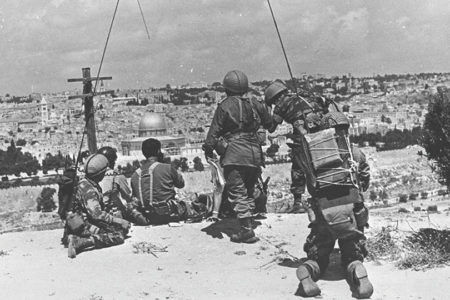Fifty Years Later
Israel hoped the 1967 war would be its last and that peace would prevail. But that has not been the case. Here is a look at the situation today.
West Bank
The Six-Day War begot the hackneyed catchphrase Israeli-occupied West Bank. Mindless talk of the “occupation” generally goes hand-in-hand with unvarnished ignorance or a willful disregard of the area’s strategic value.
The topography of the West Bank is such that no Israeli government could allow a militant Palestinian-Arab entity to control this hilly terrain that overlooks Israel’s main population centers and its main airport, Ben Gurion.
Many are unaware that there has never been a sovereign Arab state anywhere in Palestine. They are equally unaware that the West Bank happens to be the heartland of Jewish civilization, with many of the Bible’s familiar events playing out there. And yet there is no denying the 2.7 million Palestinian Arabs of the West Bank chafe under non-Muslim rule and the presence of nearly 400,000 Jewish civilians.
Golan Heights
In the north, world statesmen have long toiled to cajole Israel down from the strategic, thinly populated Golan Heights, arguing that a peace deal with Syria’s Assad dynasty would be durable. Since the outbreak of the Syrian civil war in 2011, these pressures have abated.
Sinai
The Sinai Peninsula, which Israel returned to Egypt in exchange for the 1979 peace treaty, has become a danger zone, as Islamists battle Egyptian security forces loyal to President Abdel Fattah el-Sisi.
Gaza
The Gaza Strip is about the size of Manhattan with a population of similar size (though that doesn’t stop anti-Zionists from calling it “the world’s largest open-air prison” or the “most densely populated region in the world”). After Israel unilaterally pulled out of the area in 2005, the 1.7 million Arabs there (along with those in the West Bank) promptly voted to have Hamas run their affairs. Instead of building a beautiful “Singapore on the Mediterranean,” Gaza quickly became a launching pad for attacks on Israeli settlements in the Negev. Israel has had to launch three offensives since 2005 to quell the attacks.
Jerusalem
For Jerusalem—a city embedded into the West Bank, with Samaria to the north and Judea to the south—the security situation has fluctuated. After being divided for 19 years, it was reunited in 1967. The barbed wire and concrete barriers were demolished; and the Mandelbaum Gate, a passageway for foreign travelers crossing no-man’s land between Arab “east” and Jewish “west” Jerusalem, lost its rationale. Today the Gate is recalled by a nondescript sculpture between two of the city’s light-rail stations.
Following the reunification, Jerusalem’s Arabs were granted blue Israeli identification cards, entitling them to vote in municipal elections (few do) and enroll in Israel’s vaunted healthcare system (all have).
The Hebrew University of Jerusalem was also able to return to its original Mount Scopus campus, its home from 1925 to 1948. As soon as the war ended, foreign volunteers joined Israelis to clean up the derelict grounds. And on June 28, 1967, just 18 days after the war ended, Chief of Staff Yitzhak Rabin was awarded an honorary doctorate by the Hebrew University at the very site where, on April 1, 1925, Lord Balfour had declared “with supreme confidence in its future, the Hebrew University of Jerusalem to be opened.”
Between 1948 and 1967, Mount Scopus had been inaccessible and the campus held by an Israel Defense Forces (IDF) garrison. Following the 1967 war, university President Eliahu Eilat said, “The university is now unified again, like the city. We can develop, grow—perhaps, without being presumptuous, the new Jerusalem might become a modern Athens. A city of peace and culture where people from all over the world, not only Jews, would come to perfect their education.”
Today, hundreds of Arabs study at the Hebrew University, which makes concerted efforts to integrate them. You can see students in both hijabs and yarmulkes and hear both Hebrew and Arabic being spoken.
Jerusalem is now the largest city in the Jewish state, with a population of 870,000 (63 percent Jewish and 37 percent Arab). Well over 211,000 Israeli Jews now live in neighborhoods in the east, north, and south of the city that were built on once-vacant plots that have been developed for housing since 1967. These neighborhoods are in what the international community calls “occupied East Jerusalem.”
Jerusalem no longer has the small-town atmosphere it had before the Six-Day War. Though by no means as cosmopolitan as Tel Aviv, it is home to the world-class Israel Museum, scores of art galleries, five-star hotels, an Islamic Museum, endless restaurants, a vibrant fresh-produce market, an active nightlife, and concert halls and theaters. The First Station—site of the Ottoman-period train station that opened in 1892 and closed in 1998—is the city’s premier public space, offering a range of cultural and recreational activities. There are scenic promenades shared by Jews and Arabs. The city also boasts top-notch hospitals where Arab and Jewish medical personnel tend to Arab and Jewish patients.
Milestone Year
Though 2017 is the 50th anniversary of the Six-Day War, it is also a year for other anniversaries: the 120th anniversary of the First Zionist Congress, the 100th anniversary of the Balfour Declaration, the 70th anniversary of the UN General Assembly Partition Resolution, the 40th anniversary of Egyptian President Anwar Sadat’s visit to Jerusalem, and the 30th anniversary of the first Palestinian intifada (uprising).
The Arabs’ relentless hostility to the Zionist enterprise has proven self-defeating, ruinous, and even tragic for many Palestinian Arabs. The 1967 Six-Day War may have disabused Arab leaders of the notion that they could overwhelm Israel militarily. It has not—truth be told—opened many hearts to the prospect of genuine coexistence and comity.








